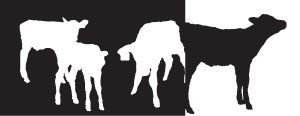Calf management has become increasingly important for many dairy producers, as scientific evidence suggests that the early stages of a heifer’s development can have long-lasting effects on her future production. As such, more attention has been given to adequate colostrum feeding soon after birth.
On many farms, it is not uncommon to supply calves with large quantities of milk or milk replacer, in some cases consuming more than 2.5 to 3 gallons per day, which has shown to have positive effects on a heifer’s future milk production.
Although it is undisputed that adequate colostrum feeding and amount of milk offered are extremely important aspects of a successful calf-rearing program, it has recently been shown that the decision to feed milk or milk replacer may also have substantial impacts. This aspect of a calf-feeding program is becoming increasingly popular due to the recent scientific findings.
Advantages of milk
Created by nature, milk can be considered as an ideal nutrient source for the newborn calf. Although the nutrient composition of milk and milk replacer may be very similar, in terms of protein, carbohydrates, fat, minerals and vitamins, milk contains a substantial amount of bioactive components that, unfortunately, cannot be reconstructed in commercial milk replacers at the current time.
Fresh whole milk is an abundant source of many bioactive components, including hormones, bioactive peptides and cytokines, that have beneficial metabolic effects on the body. Insulin, insulin-like growth factor, lactoferrin or conjugated linoleic acids are some other examples of bioactive components, but researchers agree that there are still many to discover.
Similar to colostrum, milk contains immunoglobulins; however, the concentration is much lower. It has been confirmed in many studies that these bioactive components play an important role in the growth and development of the newborn calf. When consumed, these nutrients can also exert direct, regulatory effects on the development of the digestive tract and other organs.
For example, milk contains insulin, a hormone that is mainly involved in regulation of blood glucose levels. Insulin, however, is also a strong stimulator of cell growth and proliferation. Interestingly, insulin avoids digestion in newborns and is able to exert stimulatory effects on the digestive tract, such as increasing tissue growth or efficiency of nutrient absorption.
In addition, studies suggest that bioactive components can be absorbed intact from the digestive tract and have positive effects on the development of muscle, liver and reproductive tract, as well as other organs. Similarly to immunoglobulin production in colostrum, the dam produces bioactive components in milk to provide the calf with adequate levels of these substances to ensure proper growth.
Although supplementation of bioactive components in milk replacer could be extremely beneficial, currently it is not economically plausible. A study from Switzerland demonstrated that, although supplementation of a single bioactive component in milk replacer may exert positive effects on the development of the calf digestive tract, this effect was not as beneficial when compared to prolonged colostrum feeding, an especially abundant source of bioactive components.
From this study it can be said that this unique mixture of bioactive components can have pronounced effects on calf growth and development.
It is clear that the bioactive components in milk play an important role in the stimulation of gastrointestinal tract development. A number of studies have shown that the gastrointestinal tract of calves fed whole milk developed faster in the first few weeks of life than calves fed milk replacer.
This increased development was found in the small intestine, the site of milk digestion in calves. In the late ’80s, researchers from Kansas State University were one of the first groups to determine what occurs in the small intestine when milk replacer, especially low-quality milk replacer, is offered to calves instead of whole milk.
They demonstrated that nutrient absorption was reduced when calves were fed milk replacer instead of whole milk, which we now know is mainly due to the lack of bioactive components in milk replacers.
Recently, scientists from Poland demonstrated that the growth rate of cells of the small intestine was higher in calves fed whole milk as compared to milk replacer. As a result, calves fed whole milk had a healthier gastrointestinal tract and digested and utilized nutrients more efficiently than calves fed milk replacer.
This study also demonstrated that calves fed whole milk had a more developed rumen and consumed larger amounts of calf starter in the first few weeks of life, leading researchers to believe that rumen development may be also increased in calves fed whole milk.
Milk has also been shown to have many other beneficial effects on calf development, which can lead to improved milk production in the future.
A study done by researchers from Israel showed that calves fed free-choice whole milk produced 10.3 percent more milk as a mature animal when compared to calves fed free-choice milk replacer, leading researchers and producers to question what really is the optimal feeding strategy for newborn calves.
Waste milk
For many producers, the choice to feed whole milk to calves can be easily accomplished through the use of non-saleable or dump milk. This milk from treated, fresh or high somatic cell cows is not suitable for human consumption but is economical to feed to calves.
However, quality and quantity of waste milk can vary substantially. Researchers noted that the bacterial counts of waste milk can be highly variable, resulting in depressions of average daily gain in calves as well as other health parameters.
Pasteurization is a simple and effective way to reduce the risk associated with feeding waste milk, namely through the prevention of bacterial diarrhea. Researchers have shown that when comparing performance of calves fed pasteurized waste milk to milk replacer, calves fed pasteurized non-saleable milk had lower morbidity and mortality rates and generally performed better then calves fed milk replacer.
However, calves fed non-pasteurized waste milk did not always perform better than calves fed milk replacer. This performance may indicate that the quality of pasteurized milk can be variable, while the quality of milk replacers is always consistent.
Although it is undisputable that waste milk should be pasteurized before being offered to calves, whether fresh saleable milk should be treated the same is still an open question. There are, to our knowledge, no available studies comparing pasteurized saleable milk with nonpasteurized or pasteurized unsaleable with saleable milk.
However, when considering pasteurization of fresh saleable milk, one should ask about the potential effects of pasteurization not only on bacteria counts but also on bioactive components. It is well known that high temperatures denature proteins. As most of the bioactive components in milk are proteins, pasteurization may have an effect on these highly desirable bioactive properties of milk.
Unfortunately, it seems that the optimal temperature of pasteurization for destroying substantial amounts of bacteria, while still keeping bioactive components “active,” are currently unknown. From studies on the pasteurization of colostrum it is clear that even a small increase of temperature above 140ºF greatly decreases the concentration of immunoglobulins.
Studies on human milk showed that pasteurization may reduce the content of some bioactive components in milk up to 40 percent and that the longer exposure to high temperature results in a higher percentage of “inactivated” components.
Nevertheless, the decision to forgo pasteurization may cause more harm than good due to high bacteria counts that may cause calves to scour. If pasteurization does destroy some bioactive components, a portion of them will survive, still ensuring an increase in digestive tract development when compared to milk replacer.
Producers must be familiar with their pasteurizer to take advantage of the bioactive components of milk and benefit from the role they play in a calf’s development.
For many producers, the decision to feed calves whole milk is certainly not easy, considering the economical advantages of milk replacer. Even with today’s advanced pasteurization systems, waste milk still has many imperfections considering the “inactivation” of up to 40 percent of the bioactive components.
However, there are still many advantages to feeding calves milk that have been discovered, yet the surface has only been scratched. Research in this area will surely continue in the future, in hopes of increasing the effectiveness of our heifer-rearing programs. PD
Walpole is a Ph.D. student at the University of Saskatchewan . The focus of his Ph.D. thesis examines the absorption of nutrients by the digestive tract in dairy cattle.
Gorka is a post-doctoral fellow at the University of Saskatchewan. His Ph.D. thesis concentrated on the nutritional effects on the digestive tract of calves at the University of Agriculture in Krakow , Poland.
References omitted due to space but are available upon request. Click here to email an editor.

-
Matthew Walpole
- Department of Animal and Poultry Science
- University of Saskatchewan
- Email Matthew Walpole








